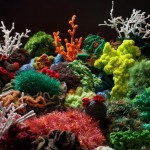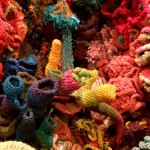The video is here. The introduction is here.
First, a suggestion for listening to Haraway (for those who haven’t done that before): If you can’t follow her, that’s okay. She isn’t taking you from point A to point Z. She will take you in a weave-like motion across the same set of crossings on different threads. Let the words and images wash over you, and, at the same time, follow the little waves that you can, then, surf-like, try to catch another one.
But having a road map helps. The following are my notes (spellings unchecked) which might help with that. Or take your own notes. Following these, I’ve added a few things from the comments from the “Disasters, responses, networks” post. In particular, I have copied Emil’s notes on the Latour piece, “On Some of the Affects of Capitalism“, below.
My question: What are the differences (alongside the complementarities), the diffractive dissonances, between Haraway’s account of the “Capitolocene” and Latour’s attempt to (effectively) mute or tone down capitalism (and its affects) by rendering it into a local form of organization that has expanded its reach to a “global domain of transcendent reality,” a “second nature”?
Haraway’s string figures in holo-bionic Seas
DH’s central question: “What happens when human exceptionalism and methodological individualism — as philosophical research commitments across the disciplines in the Euro-infused knowledge projects and their stories become literally unthinkable in the best scientific practices of our day?”
“Staying with the trouble” means not denying the level of destruction in our hands. It’s not possible to stay with the trouble without the practices of joy; these are essential.
“Sympoiesis” over “autopoiesis”: collectively producing systems as opposed to self-reproducing systems. Information and control are distributed; the systems are identified by the self-organizing factors involved in their ongoing, layered, palimpsestic generations.
String figures: figures of practice-thinking. Multispecies muddles. DH is a creature of the mud, not the sky. Muddled, not clarified, obscure, abyssal, elemental forces (both generative and destructive), before they were astralized, clarified. These powers won’t sort into the anthropocene and its before and after; they sort otherwise.
The Anthropocene: “capitalocene” is capitally better (since A-cene is premised on fossil fuels); “Chthuluocene” (Lovecraft) is still better. DH will propose a feminist Chthulu. The patron saint for this lecture is Pimoa Chthulu — the leggy one, chthonic worlding, upside-down hanging on redwood stumps. Symphonic processes.
SF: science fiction, string figures, science fact, speculative fabulation, speculative feminism, soin de ficelles, so far, et al. Scholarship as Cat’s cradle.
Inspirations: Marilyn Strathern: anthropology studies relations with relations; it matters what thoughts think thoughts, what worlds world worlds, what stories tell stories (i.e. which stories are the ones that normalize all other stories). Isabelle Stengers: the wonder and lure of abstraction; the care and feeding of abstraction. Hannah Arendt: the importance of thinking, the tragic wounding to the earth to live lives that are not thought (as with Adolf Eichmann). Tim Ingold: lines, all creatures as interwoven wayfarers. Ursula Leguin: response-ability, “The Carrier-Bag Theory of Fiction,” the container that makes us who we are, the negative spaces that hold what can be given. Thom Van Doorn: Flightways: Life and Loss at the End of Extinction; what does it mean to hold open space for another; who lives, who dies, and whose labor keeps whom alive (e.g. whooping crane).
The Anthropocene: DH is interested in complicating it. Latour’s Gifford Lectures argued for the figure of Gaia, not as goddess but as forceful open-system earth figure on which the earthbound must live, and who are at war with the human. Bruno’s Anthropos(cene) is after the fall of Babel. Anthropos = the one who looks up, from below, autopoetic, takes over from gods. The “new evolutionary synthesis” (of 1920-30s) depends on bounded units described by competition and thermodynamics equations, but does not deal with embryology, microbiology, and symboisis, i.e. the geoconjuncture which is the Earth itself.
The Anthropocene is managerial and topdown in its systems imaginations. The name and its stories can’t be sloughed off. The damage isn’t species damage; it’s a historical formation: capitalism. The Capitalocene rests on fossil fuels and is committed to making fossils. The arts project of Capital is Burning Man (of a different kind). Geophysicist Brad Warner recommended revolt, DH agrees.
Secular Gaia, Muddy Terra, Mortal Terrapolis. Dreadful Gorgon, Decomposing Medusa. The Gorgones. Medusa belongs to a queer/trans sisterhood that infected and infused Mesopotamia et al. Corals of the western sea against which the Greek heroes crash. From Medusa’s decapitated body springs Pegasus. Mistress of the animals. Tentacular SF: the tentacular ones, multisensorial. We begin to get a feel for the elemental, tentacular, abyssal, ouroboric ones. This isn’t just other critters, it’s us too. There’s a maintenance cost to maintaining critters in forms like ours.
Eco(logical)-evo(lutionary)-devo(lopmental)-histo(rical)-techno(logical)-psycho(analytical). Lynn Margulis: brought us the sciences of symbiogenesis. “Relations in MultiCritter Cosmopolitics: Sympoiesis all the Way Down.” These are what the New Synthesis couldn’t deal with. Bobtail squid hatchlings. Not organisms + environments, but a Holo-bion.
Natasha Myers (my former grad student from York, now at York 🙂 and Carla Hustak, “Involutionary Momentum”: rethinks with Darwin @ the orchid-wasp and orchid-bee symbioses. Loquacious partnering. Beauty has been regarded for so long as a luxury (even among feminists: the fear of narrative pleasure; now we realize the stupidity of that). Orchids whose flowers look like female bees. One orchid (name?) makes the flowers, but self-pollinates because the bees went extinct. The only memory of the bee is a painting by a dying flower.
Art projects: Sympoetic and symphonic worlding.
(1) Interspecies work of Beatriz de Costa. Is this extinction necessary? It’s still just barely possible to open up the spaces of flourishing. “Dying for the Other” (2012): fingering mimesis. “PigeonBlog” (2006-8). Love affairs between men and their pigeons.
(2) Margaret Wertheim, “Modeling Hyperbolic Space”: hyperbolic coral reef crochets that bring together women’s fibre arts, environmentalism, mathematics, beauty, display, intimacy without interference, question of possibility. Plastic Oceans, Bleached Coral: toxic reefs and bleached reefs, memorialized and brought into presence. Great Pacific Garbage Patch. The ubiquity of plastic in the capitolocene; the necessity of transformation in the Chthulucene. Coral Forests: fantasy figures.
(3) Desprez and Terranova. “Children of Compost: Camille’s Story” storytelling project. Corals: tentacularity. Lichens: lines, linaments. Mountaintop removal remediation. Having a baby is a community decision. The job of the Camilles is to make it possible for the monarch butterflies to keep migrating; it’s a multi-community project. If the symbiosis is broken, the Camille becomes a speaker for the dead (Orson Scott Card).
Recomposing response-ability: Terra’s compost, Gaia’s posthumus. The End.
Harlan’s link to the melancholic comic: http://xkcd.com/1259/
Latour’s 11 theses
These are Emil’s comments from the earlier post.
It’s rare and exciting to see Bruno Latour addressing capitalism so directly. His main point here is to demonstrate how our first nature, Earth, has taken a backseat to secondary nature, capitalism. In the former, laws, systems, and processes are immanent, mortal, and materially fragile, while in the second, economy, globalization, and capitalism seems transcendental, universal, and obdurate. This quote captures the spirit of Latour’s speech quite well, I think:
“We begin to see how difficult it is to disentangle the contradictory affects created by an appeal to the concept of capitalism: it generates a prodigious enthusiasm for seizing unbounded opportunities; a dystopian feeling of total helplessness for those who are submitted to its decrees; a complete disinhibition as to the long-term consequences of its action for those who profit from it; a perverse wound of smug superiority in those who have failed to fight its progression; a fascination for its iron laws in the eyes of those who claim to study its development, to the point that it appears to run more smoothly than nature itself; a total indifference to how the soil on which it is rooted is occupied; a complete confusion about who should be treated as a total stranger and who as a close neighbor. And above all, it marks a movement towards modernization that delegitimates those who stay behind as so many losers. Actually now that capitalism is thought to have no enemy, it has become a mere synonym for the implacable thrust forward of modernization. From this tangle of effects, I get no other feeling than an increased sense of helplessness. The mere invocation of capitalism renders me speechless.. It might be best to abandon the concept entirely.” (p. 9)
Yet Latour’s aim is not to grow complacent, like the radical Left that feels right (in showing capital’s real affects) but that failed nonetheless. He wants to reveal the man-made laws that drive this secondary nature that can feel more primary and loftier (in terms of change) than the primary nature that earth scientists, activists, and natural catastrophes occupy. Latour’s eleven theses, modeled after Marx’s famous critique of Feuerbach, are intended to reverse this secondary-over-primary impasse, and indeed to show that secondary nature is not governed “as a law of a transcendent world in the hands of an invisible deity.” (p. 10)
Haraway with/and/against Latour
We need to read Latour’s work on Gaia (his Gifford Lectures, which can be read in full here) and his Modes of Existence project to really get at his response to the dilemmas Haraway is responding to. Here we can only get at their respective responses to the question of capitalism and its relationship to the Anthropocene (or whatever we call this time/space/moment/situation). (Another of their interlocutors, Isabelle Stengers, with whom both Haraway and Latour have collaborated, has responded to capitalism here.)
Is the Capitalocene a more productive concept than the Anthropocene? If so, does this suggest that Marxist historical materialism (with its focus on capitalism as a historical-evolutionary formation) is, if not sufficient, at least pre-eminent among interpretations of “what’s wrong here”? What about Gaia? What about the list of neologisms Haraway has, throughout her career, invented or promoted, as she is doing here? What about art — what’s the potential of the kinds of art Haraway describes in this piece? (Latour is also interested in the arts, and is working with artists in Paris, in addition to having written an opera about Gaia.)



Adrian, you ask: “what about art..? which seems especially relevant when discussing these two thinkers. What I enjoy about Harraway is her interest in the research, thoughts, and artistic endeavors of others. She is not giving a lecture, but rather participating in an on-going conversation and engaging in “loquacious partnerships” with humans and non-human animals. She promotes being “tentacular” and multi-faceted and then demonstrates this by engaging in multifarious conversations. She is both hard to follow, and inspiring; truly committed to a non-linear approach. It’s almost as if she is name-dropping other works and thinkers that she deems worth exploration. After watching her talk I found myself looking at images from the “Museum for the Living,” a great work of art that Harraway mentioned. The artwork pays homage to animals that may become extinct soon and challenges the viewer to challenge the “established order.” All in all, I am glad we finally came around to Harraway, as she is an unusual gem.
Correction: The name of the exhibit is: “A Memorial for the Still Living” by the late Beatriz da Costa
http://www.artscatalyst.org/projects/detail/a_memorial_for_the_still_living/
Adrian, thanks for this! Fantastic resource. One question: Do you have a citation / reference for the Children of Compost (Desprez and Terranova)? It’s not, as far as I can recall, in the book Speaker for the Dead (Orson Scott Card)
Pingback: Anthropocene aesthetics (Immanence) | Uma (in)certa antropologia·